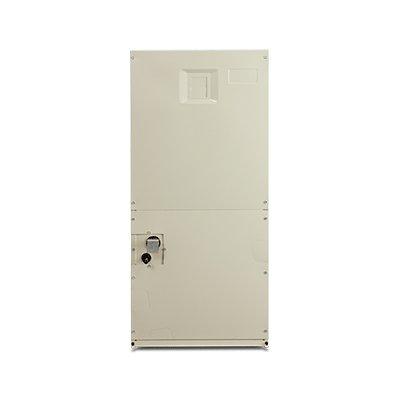An evaporative condenser is a heat exchanger for condensing a natural refrigerant gas, such as ammonia, or refrigerants of the freon family using the natural principle of evaporative cooling.
By taking advantage of the latent heat of evaporation of water, this principle allows heat to be subtracted from the refrigerant gas inside the heat exchanger and a small portion of the water sprayed onto the coil to evaporate.
Heat exchanger
Heat removal in the evaporative condenser is then accomplished by spraying water on the coil heat exchanger. The spraying of water takes place against a flow of fresh air, just as in the case of cooling towers at closed-circuit.
Unlike the latter, however, it is refrigerant gas and not water that circulates within the heat exchange coils.
wet-bulb temperature
One of the benchmarks for selecting equipment remains the ambient wet bulb temperature
One of the benchmarks for selecting equipment remains the ambient wet bulb temperature, which is that temperature determined using the psychrometric diagram from the ambient temperature and relative humidity.
Since the wet-bulb temperature is generally lower than the ambient temperature by about 4-6°C (or even higher values), Decsa can say that an evaporative condenser allows the refrigerant gas to condense at a temperature about 7-9°C higher than the wet bulb (BU).
How an evaporative condenser works
As previously mentioned, evaporative condensers are cooling systems that use the principle of evaporative cooling to cool a refrigerant gas by matching water with air.
Just as in cooling towers at closed-circuit, in the case of evaporative condensers the gas remains inside the coils isolated from the external environment; thus, two separate circuits are generated:
- The primary circuit, where refrigerant gas circulates within the heat exchange coil;
- The secondary circuit, where water contained in the collection tank located below the heat exchange coil is pumped above the heat exchange coil.
Working
That said, here is how an evaporative condenser works:
- The evaporative condenser receives from the utility a mass of high-temperature refrigerant gas-suppose ammonia that needs to be cooled;
- Ammonia begins to circulate within the heat exchange coil; at the same time, circulation of the secondary circuit is maintained in the unit;
- Water extracted from the tower collection tank is distributed through spray nozzles evenly into the exchange section above the coils, while air is blown or drawn in by fans;
- The airflow combined with the spraying of water from the secondary circuit onto the coil maximizes the effect of evaporative cooling, which, by subtracting heat from the heat exchange coil, allows the refrigerant gas to condense.
excellent performance, low consumption
The evaporation of water inside equipment is enhanced through the use of high-efficiency HDGS coils
The evaporation of water inside equipment is enhanced by Decsa through the use of high-efficiency "full-surface" HDGS coils and by balancing the L/G ratio to the best advantage.
Due to careful and researched component selection, Decsa evaporative condensers ensure excellent performance, low consumption, and, at the same time, minimal maintenance.
Scope of application
Evaporative condensers are key components of systems employing refrigeration cycles; in particular, they are used in the processes of industrial refrigeration and cold chain processes.
Below are the main areas of application:
- Cold storage facilities,
- Industrial refrigeration,
- Industrial logistics.
Why choose Decsa evaporative condensers
Available in the CFR-A axial-fan series and the CFR-C centrifugal-fan series, both models ensure minimum noise
Decsa evaporative condensers are designed by the Quality System certified to ISO 9001: 2015 standards and are designed by the 2014/68/EU (PED) directive.
Available in the CFR-A axial-fan series and the CFR-C centrifugal-fan series, both models ensure minimum noise and maximum performance efficiency.
COILS PED Certificate
All of our evaporative condensers have coils exchange certified according to PED regulations, designed and tested at 40 bar-g. PED certification is mandatory on all coils installed on products at closed-circuit containing gas and intended for the European market.
By qualitative choice, Decsa also provides the same type of battery for units intended for the non-European market. The special FULL SURFACE geometry of coils allows for maximizing the exchange surface of the coils themselves.
Structure and enclosure
Optional additional protection DecsaCOATING Plus can also be applied upon request
Decsa evaporative condensers have a structure with HDGS-Z-725 hot-dip galvanized steel panels (725 g/sqm zinc coating).
Optional additional protection DecsaCOATING Plus can also be applied upon request, which provides maximum protection on both flat surfaces and sheet punching.
Drift eliminators
The drift eliminators are made of vacuum-molded PVC foils. The special shaping, with a low-pressure drop, allows them to retain droplets entrained by the air stream, guaranteeing entrainment losses of less than 0.001%.
The separator consists of a series of specifically designed sections, ensuring simple and quick routine maintenance of evaporative condensers.




















